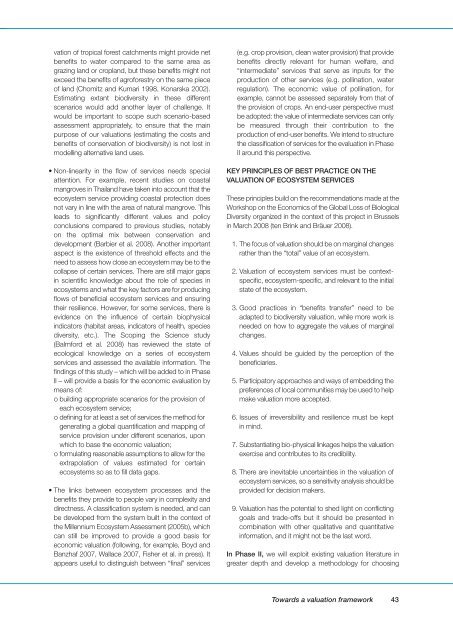Interim Report - TEEB
Interim Report - TEEB
Interim Report - TEEB
Create successful ePaper yourself
Turn your PDF publications into a flip-book with our unique Google optimized e-Paper software.
vation of tropical forest catchments might provide net<br />
benefits to water compared to the same area as<br />
grazing land or cropland, but these benefits might not<br />
exceed the benefits of agroforestry on the same piece<br />
of land (Chomitz and Kumari 1998, Konarska 2002).<br />
Estimating extant biodiversity in these different<br />
scenarios would add another layer of challenge. It<br />
would be important to scope such scenario-based<br />
assessment appropriately, to ensure that the main<br />
purpose of our valuations (estimating the costs and<br />
benefits of conservation of biodiversity) is not lost in<br />
modelling alternative land uses.<br />
• Non-linearity in the flow of services needs special<br />
attention. For example, recent studies on coastal<br />
mangroves in Thailand have taken into account that the<br />
ecosystem service providing coastal protection does<br />
not vary in line with the area of natural mangrove. This<br />
leads to significantly different values and policy<br />
conclusions compared to previous studies, notably<br />
on the optimal mix between conservation and<br />
development (Barbier et al. 2008). Another important<br />
aspect is the existence of threshold effects and the<br />
need to assess how close an ecosystem may be to the<br />
collapse of certain services. There are still major gaps<br />
in scientific knowledge about the role of species in<br />
ecosystems and what the key factors are for producing<br />
flows of beneficial ecosystem services and ensuring<br />
their resilience. However, for some services, there is<br />
evidence on the influence of certain biophysical<br />
indicators (habitat areas, indicators of health, species<br />
diversity, etc.). The Scoping the Science study<br />
(Balmford et al. 2008) has reviewed the state of<br />
ecological knowledge on a series of ecosystem<br />
services and assessed the available information. The<br />
findings of this study – which will be added to in Phase<br />
II – will provide a basis for the economic evaluation by<br />
means of:<br />
o building appropriate scenarios for the provision of<br />
each ecosystem service;<br />
o defining for at least a set of services the method for<br />
generating a global quantification and mapping of<br />
service provision under different scenarios, upon<br />
which to base the economic valuation;<br />
o formulating reasonable assumptions to allow for the<br />
extrapolation of values estimated for certain<br />
ecosystems so as to fill data gaps.<br />
• The links between ecosystem processes and the<br />
benefits they provide to people vary in complexity and<br />
directness. A classification system is needed, and can<br />
be developed from the system built in the context of<br />
the Millennium Ecosystem Assessment (2005b), which<br />
can still be improved to provide a good basis for<br />
economic valuation (following, for example, Boyd and<br />
Banzhaf 2007, Wallace 2007, Fisher et al. in press). It<br />
appears useful to distinguish between “final” services<br />
(e.g. crop provision, clean water provision) that provide<br />
benefits directly relevant for human welfare, and<br />
“intermediate” services that serve as inputs for the<br />
production of other services (e.g. pollination, water<br />
regulation). The economic value of pollination, for<br />
example, cannot be assessed separately from that of<br />
the provision of crops. An end-user perspective must<br />
be adopted: the value of intermediate services can only<br />
be measured through their contribution to the<br />
production of end-user benefits. We intend to structure<br />
the classification of services for the evaluation in Phase<br />
II around this perspective.<br />
KEY PRINCIPLES OF BEST PRACTICE ON THE<br />
VALUATION OF ECOSYSTEM SERVICES<br />
These principles build on the recommendations made at the<br />
Workshop on the Economics of the Global Loss of Biological<br />
Diversity organized in the context of this project in Brussels<br />
in March 2008 (ten Brink and Bräuer 2008).<br />
1. The focus of valuation should be on marginal changes<br />
rather than the “total” value of an ecosystem.<br />
2. Valuation of ecosystem services must be contextspecific,<br />
ecosystem-specific, and relevant to the initial<br />
state of the ecosystem.<br />
3. Good practices in “benefits transfer” need to be<br />
adapted to biodiversity valuation, while more work is<br />
needed on how to aggregate the values of marginal<br />
changes.<br />
4. Values should be guided by the perception of the<br />
beneficiaries.<br />
5. Participatory approaches and ways of embedding the<br />
preferences of local communities may be used to help<br />
make valuation more accepted.<br />
6. Issues of irreversibility and resilience must be kept<br />
in mind.<br />
7. Substantiating bio-physical linkages helps the valuation<br />
exercise and contributes to its credibility.<br />
8. There are inevitable uncertainties in the valuation of<br />
ecosystem services, so a sensitivity analysis should be<br />
provided for decision makers.<br />
9. Valuation has the potential to shed light on conflicting<br />
goals and trade-offs but it should be presented in<br />
combination with other qualitative and quantitative<br />
information, and it might not be the last word.<br />
In Phase II, we will exploit existing valuation literature in<br />
greater depth and develop a methodology for choosing<br />
Towards a valuation framework<br />
43

















